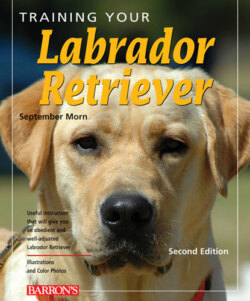Training Your Labrador Retriever

Реклама. ООО «ЛитРес», ИНН: 7719571260.
Оглавление
September Morn. Training Your Labrador Retriever
TrainingYourLabradorRetriever
Contents
1 Labrador Retriever History. Origins of the Labrador Retriever
Uses. Scent Work
Tracking
Assistance Dogs
Companionship
Lab Body and Mind
A Lab Needs a Job
Hunting
2 Choosing Your Labrador Retriever. Which Lab for You?
Which Color?
Male or Female?
What Age Is Best?
Adolescent Dogs
Adult Dogs
To Breed or Neuter?
Where to Find a Lab
Breeders
Breed Rescue
Shelters and Pounds
What Influences a Dog’s Temperament? Environment
Heredity
Interpreting a Pedigree
3 The First Month with Your New Lab. The Bonding Period
Teaching Rules and Limits
House-training
House-soiling Problems
Confinement
A Puppy Corral
Crates
Crate-training
“Instant” Crate-training
How Long Can a Dog Be Crated?
Pet Doors
Fences, Kennels, Tie-outs
Dog-proofing Your House and Yard
Anticipating and Avoiding Hazards
Ingestible Hazards
Prevention
Teaching Not to Chew
Exploring and Escaping
Home and Garden Dangers
The Dangers of Swimming Pools
Safety Commands
Wait
Leave It
Come Away
Safety in and Around Vehicles
Your Lab’s ID
4 Training Equipment
Collars
Flat Collars
Slip “Choke” Collar
Pinch or Prong Collars
Limited Slip or “Combination” or “Martingale” Collars
Head Halters
Harnesses
Leashes
Traffic Leads
Walking Leads
Training Leads
Retractable Leads
Long Lines
5 Leadership and Mutual Respect. What Is a Pack Leader?
Reasons Not to Use Dominance Training
Trust Training
Family Members and Children
Socialization
People Friends
Dog Friends
Puppy Kindergarten
6 Health
Immunization
Environment—Housing, Diet, Grooming, Exercise
Housing
Diet
Grooming
Exercise
Teaching Your Lab to Accept Health Care
Massage for Health
Taking Medicine
Becoming Friends with the Veterinarian
7 Motivating Your Labrador. How Motivation Works
Using Rewards
Treat Rewards
Praise
Voice Tone
Physical Touch
Hunting and Chasing
Play
8 Communicating with Your Lab. Capturing and Holding Your Dog’s Attention
Attention Training
Eye Contact
Hand Signals
Understanding Dog Language
Body Posture
Calming Signals
Facial and Eye Expressions
Touch
Vocal Sounds
9 Commands—A Basic Vocabulary. Dogs and Language
Health Check
Positive Obedience Training
Using Food Lures
Walking on Leash
Informal Walking
Wait
Heel and Automatic Sit (Formal Walking)
The Formal Recall
Finish to Heel
Graduating to Off-leash Work
Commands in Daily Life
10 Tricks. Tricks and Obedience
Clicker Training
11 Games and Family Fun. Forming Life Skills Through Play
Good Toys/Bad Toys
Bones?
Games for the Whole Family
Thank You/Take It
Tug-of-Peace
Fetch
Go Find
Go Wild and Freeze
Go Play/Come Away
Fun Outdoor Activities with the Family. Camping
Day Hikes and Picnics
Boating Fun and Safety
Parades, Walkathons, Community Fun
12 Building Your Lab’s Confidence
Sensitive Periods
Fear of the Unknown
Promoting Trust
Belly Up (Lie on Back)
Mouth Handling
Calming Massage
Easy Agility Obstacles
Working Through Fears
Fear of Sounds
Fear of Fireworks
Fear of Objects
Fear of Grooming
Fear of Paw Handling
Fear of People
Fear of Other Dogs
Fear of Vehicles
13 Overcoming Behavior Problems. Handling Bad Habits
Correction and Punishment
House Soiling
Young Pups
Adolescent and Adult Dogs
Senior Dogs
Marking Problems
Nuisance Behaviors
Jumping Up on People
Chasing
Mouthing and Nipping
Excessive Barking
Refusal to Come
Begging
Stealing
Shredding and Trashing
Roaming
Digging
Aggression Problems
14 Canine Good Citizen Test. The CGC Certification Program
Responsible Dog Ownership
Preparing for the CGC Test
Ten Exercises That Make Up the CGC Test
Test 1: Accepting a Friendly Stranger
Test 2: Sitting for Petting
Test 3: Appearance and Grooming
Test 4: Out for a Walk (On a Loose Leash)
Test 5: Walking Through a Crowd
Test 6: Sit and Down on Command/Staying in Place
Test 7: Coming When Called
Test 8: Reaction to Another Dog
Test 9: Reactions to Distractions
Test 10: Supervised Separation
CGC Programs in Other Countries
15 Competition and Titles. Overview
Conformation
Obedience Trials, Tests, and Titles
Rally
Tracking
Field Trials—Hunting and Retrieving
Agility
16 Sports. Avoiding Injuries
Suggested Sports
Flyball
Flying Disk Catch
Musical Freestyle Obedience
Water Sports
Dock Jumping
Additional Outdoor Activities
Skijoring
Mushing
Carting
17 Careers for Labs
Assistance Dogs
Therapy Dogs
Search Dogs
Show Biz
18 Legal Issues. Community Responsibility
Dog Waste Pickup and Disposal
Licensing and Local Laws
Fairness to Neighbors—Fences
Electric Fences for Inventive Escapers
Electronic Containment Systems
Boredom Causes Misbehavior
Borders and Quarantines
Protecting Your Lab
Temperament and Intelligence Tests. Puppy Temperament Test
Scoring Directions
Interpreting Your Puppy’s Score
Puppy I.Q. Test
Scoring Directions
Interpreting Your Puppy’s Score
Useful Addresses and Literature. Books
Organizations
Behavior/Training
Breed Associations
Rescue
Sporting Activities
Working Activities
Periodicals and Newsletters
Glossary
Index
Отрывок из книги
2nd Edition
September B. Morn
.....
A traditional job for a Lab is hunting retriever. This breed shines at this work, and most take to retrieving game birds as if remembering how, rather than learning something new. Commands must be learned by voice, hand, and whistle. Complicated and multiple retrieves must be practiced; skills must be refined. A good rapport between dog and handler must be built and nurtured.
Hunting seasons often last only a few weeks, but hunting dogs are athletes and must have activity to keep them occupied and fit the rest of the year. Training for Field Trial, Obedience, Tracking, or Agility competition is a great off-season way to keep Buddy active and fit year-round.
.....